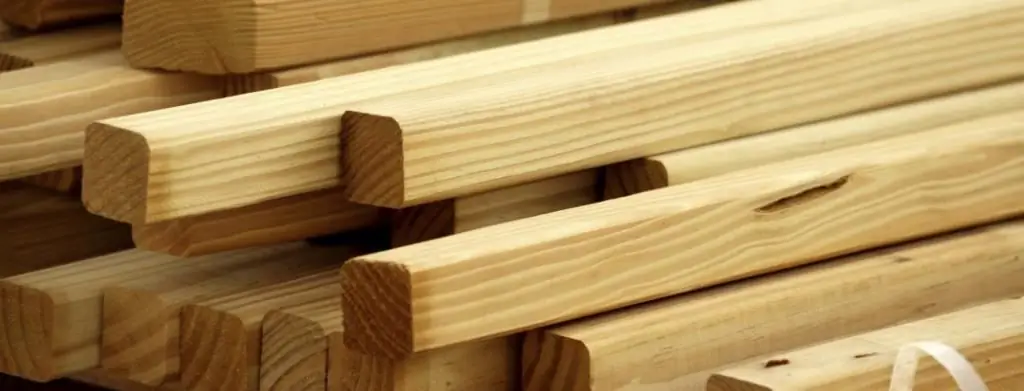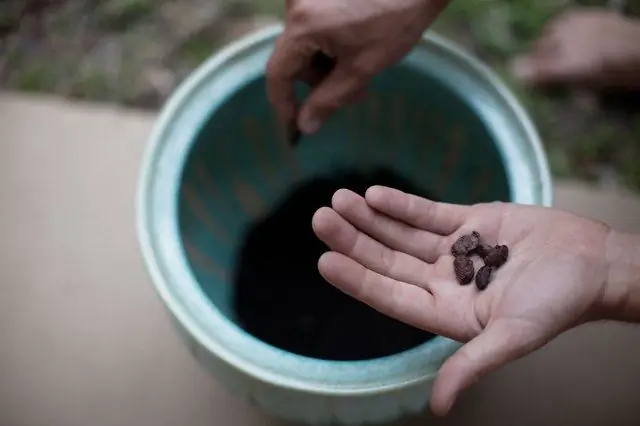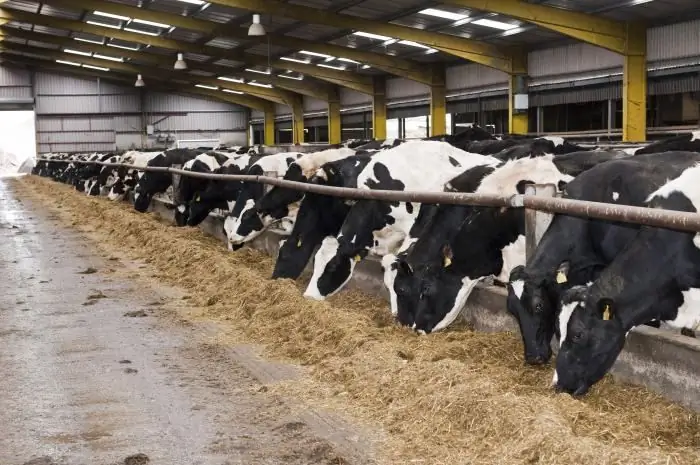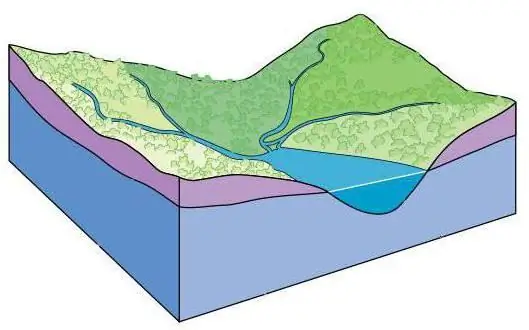2025 Author: Howard Calhoun | [email protected]. Last modified: 2025-01-24 13:10:35
Most houses have centralized water supply. But due to remoteness from the settlement or for other reasons, in some country cottages, it is not available at the dachas. The owners have to drill a well or equip a well.
To determine the horizon of the source, you have to resort to the help of a professional. His services are not cheap. The depth of groundwater can be set independently. At the same time, it will be possible to significantly save the family budget for the arrangement of the water supply system. To do this, several simple approaches are used. Before starting work, it is necessary to consider the entire procedure in detail.
Groundwater type
The depth of the groundwater level is different. The type of source depends on this indicator. It is taken into account when conducting a water supply system. The layer closest to the surface is called the top layer. It is located at a depth of 2-3 m. Such a source is applicable only for technical purposes.

Followed by groundwaterwith a free surface. There are also interstratal non-pressure and pressure artesian springs. The most pure, drinkable is the last variety. The chemical composition and quality are the highest among all sources. The water layer can run through sandy, clayey or gravel soils.
Features of groundwater
Before determining the depth of groundwater, you need to learn about their features. First of all, their location is influenced by the type of terrain. In the steppe, where the surface is flat, the layers lie evenly. At any point, their depth is the same.

But in the presence of bumps, slides, the water is also curved. Experts recommend taking into account such features of the relief when creating a well. If you need water for technical purposes, you can use the first layer. He comes closest to the surface.
For drinking purposes, it is necessary to use water from at least the second layer. If the area is hilly, it is better to drill a well on a hill. In this case, a layer of soil will better filter out such water.
In swampy areas, groundwater can approach the surface at a depth of only 1 m. When developing a well, you need to be prepared for this.
Ground waters of the Moscow region
Before drilling a well, owners of their own home should inquire about the features of the layers of underground sources. For example, the depth of groundwater in the Moscow region is characterized by heterogeneity.
There are 5 main layers here. All of themunequally located and have different power. The first three layers are characterized by low pressure. They are used for technical purposes. Water discharge occurs in small streams and rivers. This groundwater is replenished in the spring when the snow begins to melt.

The two lower layers lie in dolomite and limestone rocks. The depth of their occurrence is about 100 m. It is these sources that are suitable for drinking purposes. In the Moscow region, the central water supply was laid from these sources.
Preparation for measurement
Moisture conditions and groundwater depth are quite closely related. If you are going to take measurements, you need to choose the right time. At the same time, there should be neither drought nor prolonged rains. All weather conditions affect the measurement result.

To determine the depth of groundwater, you must use one of the simple methods. To do this, you need to prepare all improvised means and materials. Of the tools you will need an ordinary bayonet shovel, drill, tape measure. You also need to prepare a long rope.
In addition to tools, certain chemical elements are needed. These are sulfur, quicklime and copper sulfate. Different methods will require certain available tools.
Drilling
Determining the depth of groundwater is possible using several methods. The most reliable of them is drilling. Whereinit is possible to determine exactly how deep the underground source is, whether there are significant obstacles in the form of stones on the way to it.

An ordinary factory drill is suitable for work. If desired, additional blades are welded onto its blades. The tool cuts into soft ground. It is taken along with the earth to the surface. To soften the soil, it is poured with water.
With the help of a threaded, spigot connection, the drill is fastened to the pipes in order to go deep to the desired level. Next, with the help of a rope, measurements are taken. The well should be 0.5-1 m deeper than the water surface. They attach paper to the rope and check at what level it gets wet.
Using chemicals
If you do not want to drill a well, there is an easier way to find out the depth of groundwater. To do this, dig a hole in the intended place with a shovel. It can be about 0.5 m deep. It requires a clay pot.
Quicklime, sulfur and blue vitriol are mixed in equal proportions in a vessel. Next, the hole is dug in and left for a day. After that, the pot is taken to the surface and weighed. The heavier it became, the closer the groundwater comes to the surface. This method is not accurate enough, but it has been used since ancient times. Only now it has been improved.
Barometer
Another reliable way to determine the depth of groundwater in a given area is to use a barometer. However, it should be noted that for its applicationpresence in the vicinity of the reservoir is required.
If there is one, you can start measuring. Each division of the barometer corresponds to 1 m of depth. First, with the device you need to go to the reservoir. Here the barometer readings are recorded.
Then they depart from the reservoir to the proposed well drilling site. Instrument readings are marked. The difference between the first and second measurements is approximately equal to the depth of the underground source.

This method is also not very accurate. The error distorts the real picture. But the general principle can be understood.
Folk way
The depth of groundwater can be determined by folk methods. First of all, you need to pay attention to the vegetation. Where the source comes close to the surface, it is greener, brighter. In such places, reeds, ivy, forget-me-nots and other moisture-loving representatives of the flora love to grow.
The folk approach suggests the following. It is necessary to wash in soapy water and dry the coat well. Vegetation is being removed at the proposed site for the experiment.
Wool is laid out on the ground. A raw egg is laid on it and everything is covered with a frying pan. In the morning evaluate the result of the experiment. If the egg and woolen bedding are covered with dew drops, then the water is close to the surface. But this procedure should be carried out in dry weather.
Having considered how the depth of groundwater is determined, you can independently make measurements. Depending on the chosen method, you can get a more accurate or approximateresult. All work can be done independently. This will significantly save the family budget.
Recommended:
Determining the need for personnel: the concept, planning methods and ways to cover it

One of the most valuable resources of any company is its staff. However, it is quite expensive. Therefore, it is extremely important to determine the number of employees in which you can achieve the maximum economic effect at the lowest cost. For this, special methods and approaches are used. Determining the need for personnel is one of the priority tasks of management. How this process is carried out will be discussed in the article
Comparative approach. Methods for determining the value of real estate

Comparative approach in real estate appraisal is the most popular method that gives the best results in the analysis of determining the real value
Methods for determining the density of dry pine

Any material has a certain density, but in some cases it may be different, for example, for wood. The density of this material is different for different types of wood. It depends on the origin of the tree, the weather and many other factors
Sowing qualities of seeds: methods for determining the purity and waste of seeds

The yield of crops depends significantly on such an indicator as the sowing quality of seeds. Planting material must meet not only varietal requirements. It must also be sufficiently clean, viable, dry and viable
Cow life expectancy: factors and methods for determining age

Everyone knows the average life expectancy of a person, but he is not alone on earth. There are many animals without which mankind cannot exist, and it has been so since ancient times. But no one ever thinks about how long our friends and helpers, and sometimes breadwinners, should live. For example, how long does a cow live?

